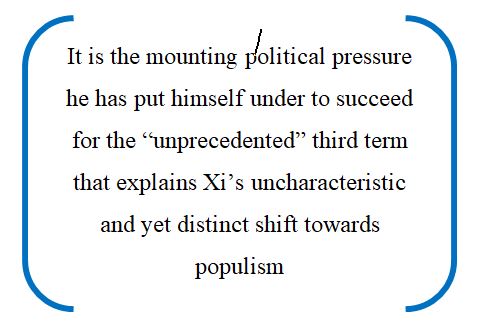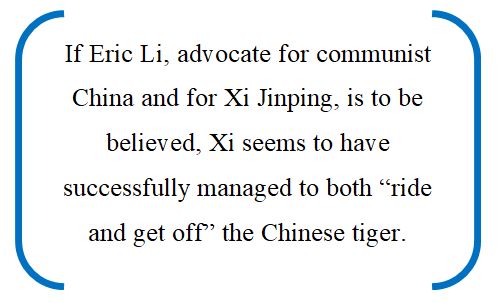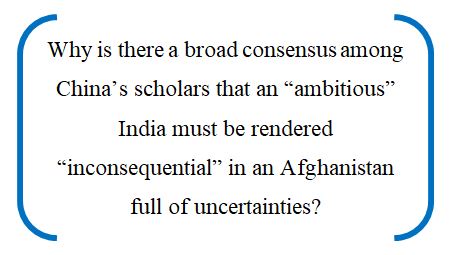Hemant Adlakha, Vice Chairperson, ICS and Associate Professor, Jawaharlal Nehru University.

Source: twitter.com
A Chinese idiom says: If you ride a tiger, it’s hard to get off! Since being handed over China’s reign by the CPC a decade ago, Xi Jinping hasn’t experienced “the year of the tiger.” He will be riding into the tiger year this Chinese zodiac year – a crucial year for him. Speculations are high in the People’s Republic as everyone is asking: does Xi know how to get off a tiger?

It is well-known that the tiger occupies a unique position in traditional Chinese mythology. Of the twelve Chinese zodiac animals, tigers are known to have potent personalities. They are considered to be strong, brash, impetuous and, above all, self-assured. However, while they are potent personalities, at the same time they are fundamentally dangerous. Xi Jinping emerged as the top communist party leader in China in November 2012 – two years after the last year of the tiger in 2010. Remember, in 2010 China edged out Japan and became the world’s second largest economy after the US. This year will be the first time Xi Jinping will be leading China into the year of the tiger. In fact, as observers tell us, Xi will usher China “riding a tiger” as the leader of the world’s largest economy.
But does he know how to get off a tiger? For, in recent years, Chinese politics has increasingly become too “hot” at the top and is not for someone with a weak heart – especially when compared with the days of Jiang Zemin and Hu Jintao, respectively. Of course, no one can disagree, Xi Jinping has been under mounting pressure since the last CPC Party Congress in 2017, when he forced his “Thoughts” into the party constitution and got rid of the 2-term limit to his leadership of the party and of the PRC. Hence, it is the mounting political pressure he has put himself under to succeed for the “unprecedented” third term at the top that explains Xi’s uncharacteristic and yet distinct shift towards populism during the entire past one year.

Source: studycli.org
Some say it is the widening social inequality – and Xi did not do anything for the first eight years – the biggest driving force behind Xi’s emphasis last year on “common prosperity.” Last August, Xi’s call for “prosperity of all” at the Central Committee for Financial and Economic Affairs stands out as the most populist of his series of “populism” measures announced last year. Other populist announcements include massive national propaganda that China has abolished “absolute poverty”; steps to rein-in China’s monopoly capitalists such as big and large “fin-tech” entrepreneurs Alibaba’s Jack Ma and Tencent’s Pony Ma, among others; shutting down of highly profitable private online coaching shops that dominate the education industry; and last but not least is the state cracking down on Didi online cab service and on the real estate businesses.

Furthermore, just like Xi did not, or could not, do anything substantive to bridge yawning inequality during his two terms as the top leader, he also failed to carry it through to the end the campaign against corruption. Remember the great enthusiasm with which the new leader had launched the “anti-corruption” movement on coming to office in 2012. However, soon the common people in China could see through the hollow slogan Xi had coined at the time: we must uphold the fighting of “tigers” and “flies” at the same time. Though anti-corruption rhetoric has been maintained at a high pitch, yet it remained a mere propaganda and failed to “destabilize the rotten bureaucratic apparatus on which the CPC relies to rule.” At the end of Xi’s ten years of rule, likewise, calls for “common prosperity” – the so-called philanthropy from the super-rich and the need to reduce social inequality, are seen as mere “populism” aimed at deflecting rising discontent and resentment mostly among rural migrant workers and vast majority of marginalized rural youth.

Source: wgm8.com
Ever since the CPC general secretary Xi declared, or some say claimed, the party has apparently extended its full support and endorsed Xi as the “core” leader and abandoned the principle of collective leadership. The global media as well as scholars abroad have been critical of the PRC president for “leading China away from the hybrid path taken by Deng Xiaoping and returning to a system of absolute rule by one individual without term limits, as under Mao Zedong.” Xi is also accused of returning China on “the road to disaster” by turning the CPC leadership back from authoritarianism towards one-person dictatorship. Moreover, serious doubts have been expressed over whether “unstoppable” Xi can end the world’s largest economy’s (in size) “Gilded Age” and lead China into “its own era of progressive reform.”
It is in this above backdrop, president Xi’s sudden, high-pitched “populism” in the past one year must be analysed, for political as well as for economic reasons. On the one hand, Xi’s populism actually relies upon “socialist nihilism” to quell ideological challenges from the Chinese left. On the other hand, Xi is using the state-led propaganda of “abolishing of absolute poverty” and “prosperity for all” as a political instrument to dupe the working people of China. As Joschka Fischer has explained in a Project Syndicate column recently, perhaps Xi may be right in thinking that for the CPC, a change in direction is clearly needed. “For Xi, the Chinese hybrid model that has developed since Deng now needs a fundamental readjustment and social reorientation to account for the escalating political confrontation with the US and the decline of the economy’s growth rate,” Fischer noted.

However, within China, in a nutshell, disregarding all the populist moves in the course of the year just gone by in which Xi has tried to drum up for consolidating his quest for the third term, his only claim to enjoying wider popularity within China is perhaps the manner in which Xi and his team managed to keep low the pandemic death toll. As according to Eric Li, a Shanghai-based venture capitalist and political scientist, once President Xi took charge of leading China’s counter fight against the epidemic – following Xi’s virtual meeting with the head of the WHO on January 28, 2020 – he has shown that “opportunism and shirking responsibility” are not in his leadership character. Li does not disagree that the Wuhan authorities had erred in the early stages of the virus outbreak about which very little was known. And the unexplained delay resulted in justified public anger – best manifested in Wuhan Diary written by the city-based well-known writer, Fang Fang – especially at the initial silencing of the whistleblowing Dr. Li. But Xi’s decision to lockdown Wuhan city and Hubei province turned out to be “the decision that saved the nation from a devastating catastrophe,” noted Eric Li.

Finally, if Mao Zedong and Deng Xiaoping both could be credited to possess the required political skill to be able to both ride and get off a tiger – Mao for his extraordinary ability to lead China on the disastrous path to Great Leap Forward, Cultural Revolution and yet he continues to enjoy god-like status today, while Deng having had emerged from “three lows and three downs” into “chief architect” of a strong, modern China. In comparison, Xi’s only claim to be endowed with the unique Chinese skill “to ride and get off a tiger” lies is his ability to act with unprecedented high degree of firmness and character to lead China’s “people’s war” against a once-in-a-generation pandemic crisis. The world is still fighting the war to contain the corona pandemic, with both the number of infected cases and death toll rising. So is China. But with a difference – China has a communist party and Xi Jinping. If Eric Li, advocate for communist China and for Xi Jinping, is to be believed, Xi seems to have successfully managed to both “ride and get off” the Chinese tiger. This blog was earlier published by thinkchina.sg on 20 January, 2022 under the title “Can Xi Jinping ride the tiger year with success?”.













































